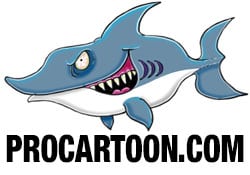Watercolor pencils – Used by the great masters!
Watercolor pencils are some of my favourite art tools, second only to graphics tablets. They are such a versatile, accurate and easy to use watercolor paint medium that are an absolute pleasure to work with.
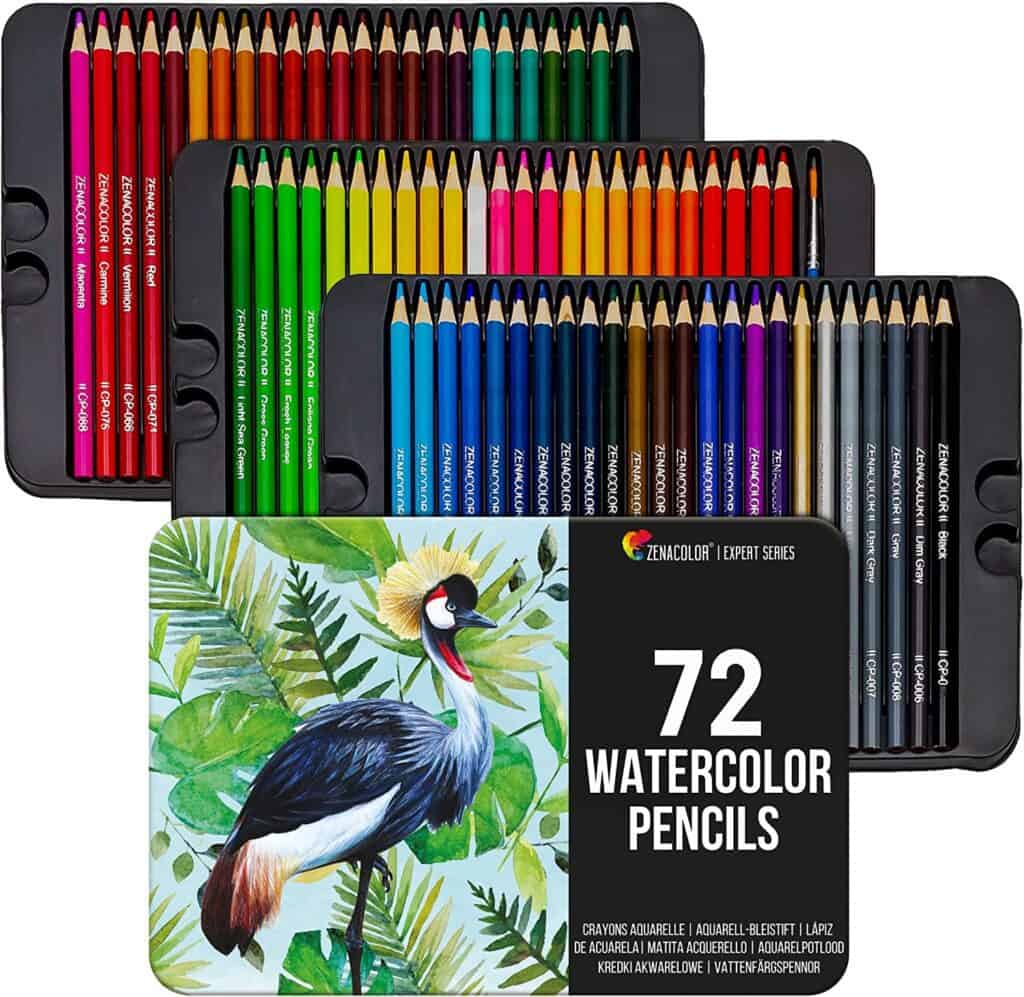
Did you know that they are not a modern artists tool? – They have been in existence for centuries and have been used to create some of the most famous paintings, which may surprise you – read on to find out…
The history of watercolor pencils
The history of watercolor pencils is not well documented, but it is likely that they were developed as an evolution of traditional watercolor paints. Watercolor paints have been used by artists for centuries. They were traditionally made by grinding and mixing pigments with a binder, such as gum arabic. This created a paint that could be thinned and layered to provide a range of effects. It is possible they were developed as a way to make watercolor paints more convenient and easier to use. Encapsulating the pigments in a pencil form that could be sharpened and used like a traditional pencil.
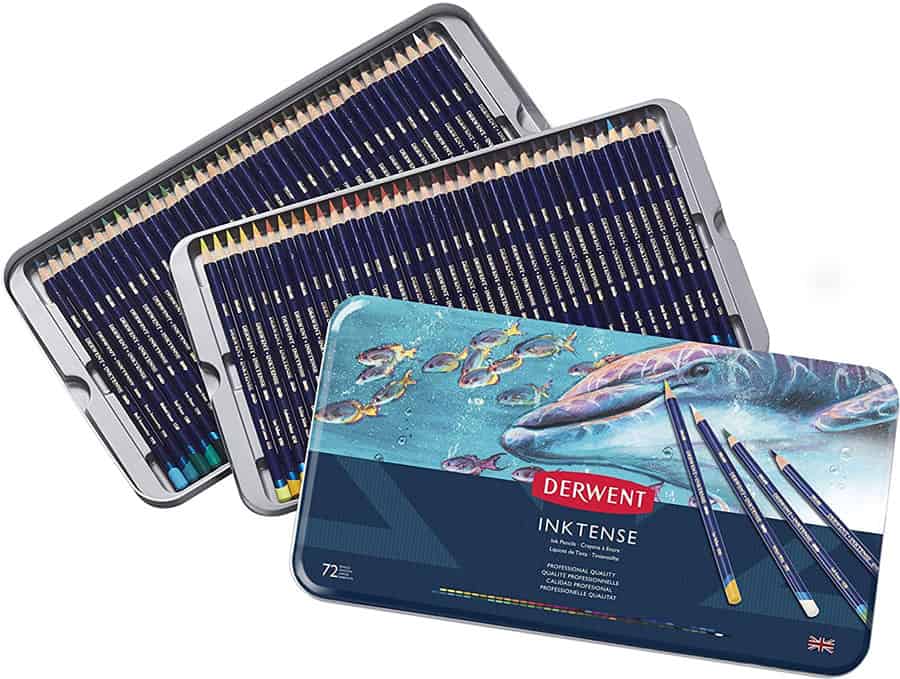
Watercolor pencils have become increasingly popular in recent years. They offer a convenient and portable way for artists to create watercolor effects without the need for tubes of paint and a palette. Often used by artists who work on the go, or who prefer a more controlled and precise method of applying watercolors. Watercolor pencils are also a popular choice for beginners. They can be used to create a range of effects without the need for a lot of specialized equipment or materials.
Which famous artists use watercolor pencils?
Watercolor pencils have been used by many famous artists throughout history. Some well-known artists who have used watercolor pencils in their work include:
- John Singer Sargent: John Singer Sargent was an American portrait painter who was known for his skill in watercolor painting. He often used watercolor pencils to create detailed and precise drawings that he could later paint over with watercolors.
- Paul Klee: Paul Klee was a Swiss-German artist who was known for his use of watercolor pencils. He often used them to create detailed and expressive drawings that combined elements of abstraction and realism.
- Henri Matisse: Henri Matisse was a French painter, printmaker, and sculptor. Matisse was known for his use of bright, bold colors and his expressive, fluid brushstrokes. He often used watercolor pencils to create preliminary sketches for his paintings, as well as finished works of art.
- David Hockney: David Hockney is an English painter, printmaker, and stage designer. Hockney is known for his use of watercolor pencils. He often used them to create detailed and precise drawings that he later painted over with watercolors.
- John Everett Millais: John Everett Millais was an English painter and illustrator. He often used water color pencils to create detailed and precise drawings that he later painted over with watercolors.
These are just a few examples of famous artists who have used this medium in their work. Many other artists have also used these versatile tools to create a wide range of effects and styles.
Famous paintings produced with watercolour pencils

There have been many famous paintings produced with watercolor pencils throughout history. Some examples of well-known paintings that were produced using watercolor pencils include:
- “The Dream” by Henri Matisse: This painting was created by Henri Matisse using watercolor pencils, along with other media such as gouache and ink. It is a vibrant and expressive work that is known for its bold use of color and fluid brushstrokes.
- “The Blue Boy” by Thomas Gainsborough: This iconic painting was created by Thomas Gainsborough using watercolor pencils, along with other media such as oil paint and pastel. It is a portrait of a young boy dressed in blue, and is known for its delicate and detailed brushwork.
- “The Scream” by Edvard Munch: This iconic painting was created by Edvard Munch using watercolor pencils, along with other media such as pastel and charcoal. It is a powerful and expressive work that is known for its use of bold, expressive lines and vivid colors.
- “The Persistence of Memory” by Salvador Dali: This surrealist painting was created by Salvador Dali using watercolor pencils, along with other media such as oil paint and ink. It is a highly imaginative and dreamlike work that is known for its unusual and surreal imagery.
- “Girl with a Pearl Earring” by Johannes Vermeer: This iconic painting was created by Johannes Vermeer using watercolor pencils, along with other media such as oil paint and pastel. It is a portrait of a young woman wearing a pearl earring, and is known for its delicate and detailed brushwork.
These are just a few examples of famous paintings that were produced using watercolor pencils. Many other famous paintings have also been created using these versatile art supplies.
The pigment in is made of finely ground particles of colorant that are suspended in a binder material. The colorant used in watercolor pencils can be made from a variety of substances. This includes natural pigments such as mineral pigments, vegetable dyes, and animal dyes. Synthetic pigments are also used, created through chemical processes.
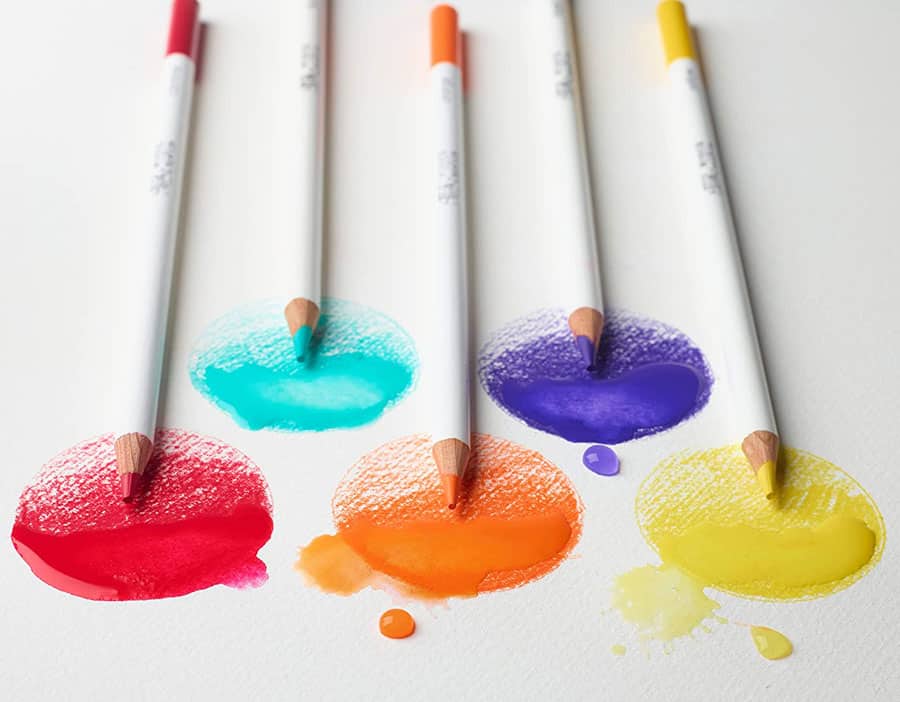
The binder material used is typically a water-soluble substance, such as gum arabic or glycerin. This helps to hold the pigment particles together and allows them to be easily dissolved in water. When water is applied to the marks made, the binder material dissolves and releases the pigment particles. The particles then mix with the water to create a watercolor paint effect.
Some pencils are made with a high-quality, lightfast pigment that is resistant to fading. Other pencils may use less expensive, less lightfast pigments that may fade or change color over time when exposed to light. It is important for artists to consider the quality and lightfastness of the pigments, as this can affect the longevity and stability of their artwork.
Which are the best?
There are many varieties on the market. The best ones for you will depend on your personal preferences and needs. Here are a few factors to consider when choosing watercolor pencils:
- Quality of the pencils: Look for pencils that are made with high-quality pigments and that produce vibrant, rich colors when used.
- Types of pencils available: They come in a range of types, including hard, soft, and water-soluble. Hard pencils are good for fine detail work. Soft pencils are better for larger areas and for creating softer, more blended effects. Water-soluble pencils can be used wet or dry. They are a good choice for those who want the versatility of both.
- Brand reputation: Some brands of have a better reputation than others for their quality and performance. Research different brands and read reviews from other artists to find the best option for you.
- Price: There is a huge variation in price, with some more expensive options offering higher-quality pigments and better performance. Decide on a budget and look for pencils that offer good value for money within that range.
Some popular brands of watercolor pencils include Faber-Castell, Prismacolor, Derwent, and Winsor & Newton. It’s a good idea to try out a few different brands and types to see which ones work best for you.
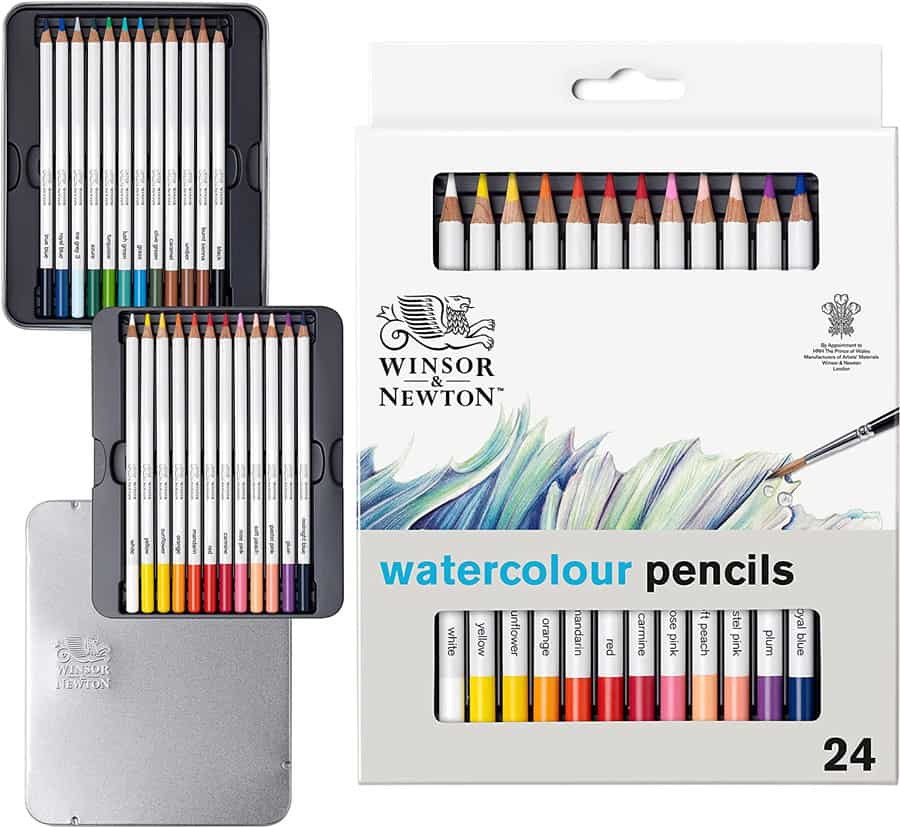
How do you use watercolour pencils?
Watercolor pencils can be used in a number of ways to create a wide range of effects. Here are a few tips for using watercolor pencils:
- Dry application: Watercolor pencils can be used just like regular colored pencils, by drawing directly onto paper and coloring in the desired areas. This is a good way to create fine, detailed work, or to lay down a base layer of color before adding water.
- Wet application: You’ll need a paintbrush and some water. Wet the area you want to color with a paintbrush, and then use the watercolor pencil to add color. The wetter the area, the more the pencil’s color will spread and blend. You can also wet the pencil itself before applying it to the paper for a more intense color.
- Layering: Watercolor pencils can be layered on top of each other to create new colors and more complex compositions. Just make sure to allow each layer to dry before adding the next.
- Blending: You can use a wet paintbrush to blend colors together for a softer, more seamless look. You can also use a blending tool, such as a blending stump or a cotton swab, to smooth out rough edges and blend colors together.
- Fixative: If you want to prevent your artwork from smudging or running, you can use a fixative spray to set the colors. Just make sure to use a fixative that is compatible with watercolors.
What advantages do watercolour pencils have over conventional watercolor paints?
There are a few advantages:
- Convenience: Portable and easy to use, making them a good choice for artists on the go. They don’t require tubes of paint or a palette, and they can be easily carried in a pencil case or art supply bag.
- Precision: Because watercolor pencils are solid and can be sharpened, they offer more control and precision than watercolor paints, which can be difficult to control. This makes watercolor pencils a good choice for detailed work or for creating fine lines.
- Versatility: They can be used wet or dry, which gives you more options for creating different effects. You can use them to create both detailed, precise lines and soft, blended areas of color.
- Longevity: Watercolor pencils are less prone to drying out than watercolor paints, so they have a longer shelf life. This makes them a good investment for artists who don’t use watercolors frequently.
However, watercolor paints have their own set of advantages as well. They tend to have a more vibrant and luminous appearance, and they are easier to mix and blend than watercolor pencils. Watercolor paints also allow for more layering and glazing techniques, which can create complex, nuanced color effects. Ultimately, the choice between watercolor pencils and paints will depend on your personal preferences and needs as an artist.
Are watercolor pencils lightfast?
Watercolor pencils are a type of artist’s pencil that contains a water-soluble pigment. When used dry, they can be used like regular pencils to draw and sketch. When the drawing is wetted with a brush, the pigment dissolves and spreads, creating a watercolor effect.
The lightfastness of watercolor pencils depends on the quality of the pigments used in the pencils. Some pigments are more lightfast than others. This means they are less prone to fading or changing color over time when exposed to light.
To ensure that your watercolor pencil drawings are lightfast, it is important to use high-quality pencils that are made with lightfast pigments. Some pencil brands may label their pencils as “lightfast” or provide information about the lightfastness of the pigments they use. You can also check the ASTM (American Society for Testing and Materials) rating of the pencils, which rates the lightfastness of art materials on a scale of 1 to 8. 1 being the least lightfast and 8 being the most lightfast.
It is also important to store your watercolor pencil drawings in a place that is not exposed to direct sunlight or other sources of intense light, as this can cause the pigments to fade or change color over time.
In summary, the lightfastness of watercolor pencils depends on the quality of the pigments used and how the drawings are stored. High-quality pencils made with lightfast pigments and storing your drawings in a place that is not exposed to direct light can help. This will ensure your watercolor pencil drawings will remain vibrant and true to color over time.
How are watercolor pencils manufactured?
Watercolor pencils are typically manufactured by grinding pigment particles into a fine powder and mixing them with a binder material to create a paste. The paste is then shaped into pencil form, using a machine that encases the paste in a wooden or plastic casing to create the pencil shape. The pencils are then allowed to dry, and are sharpened to a point using a pencil sharpener.
The process of manufacturing watercolor pencils may vary slightly depending on the specific brand and type of pencil being produced. Some watercolor pencils may be made using a higher percentage of pigment, which results in a more vibrant and opaque color when used dry. Other watercolor pencils may be made with a lower percentage of pigment, which results in a more transparent and subtle color when used wet.
The quality of the pigments and binder materials used in watercolor pencils can also affect the manufacturing process. High-quality watercolor pencils may use more expensive, lightfast pigments that are resistant to fading over time. Lower-quality pencils may use less expensive, less lightfast pigments that may fade or change color over time when exposed to light. The binder material used in watercolor pencils is also an important factor, as it determines the water-solubility of the pencils and the stability of the colors when wet.
How much do watercolor pencils cost?
The cost of watercolor pencils can vary widely, depending on the brand, the quality of the pigments, and the number of pencils in the set. Some basic sets can cost as little as $10-$20 for a set of 12-24 pencils, High-end sets can cost $50 or more for a set of 12-24 pencils. Individual watercolor pencils can cost anywhere from $1-$3 each, depending on the brand and quality of the pencil.
In general, it is important to consider the quality of the pigments and binder materials used in watercolor pencils when purchasing them. Higher-quality pencils may cost more, but they may also produce more vibrant and stable colors that are less prone to fading or bleeding when wet. It is also worth considering the size of the set and the number of pencils included. Larger sets may offer a wider range of colors and may be a more cost-effective option for artists who use them frequently.
